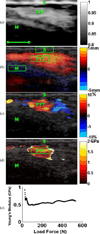Ultrasound elasticity imaging for determining the mechanical properties of human posterior tibial tendon: a cadaveric study
- PMID: 25532163
- PMCID: PMC4754123
- DOI: 10.1109/TBME.2014.2381002
Ultrasound elasticity imaging for determining the mechanical properties of human posterior tibial tendon: a cadaveric study
Abstract
Posterior tibial tendon dysfunction (PTTD) is a common degenerative condition leading to a severe impairment of gait. There is currently no effective method to determine whether a patient with advanced PTTD would benefit from several months of bracing and physical therapy or ultimately require surgery. Tendon degeneration is closely associated with irreversible degradation of its collagen structure, leading to changes to its mechanical properties. If these properties could be monitored in vivo, they could be used to quantify the severity of tendonosis and help determine the appropriate treatment. The goal of this cadaveric study was, therefore, to develop and validate ultrasound elasticity imaging (UEI) as a potentially noninvasive technique for quantifying tendon mechanical properties. Five human cadaver feet were mounted in a materials testing system (MTS), while the posterior tibial tendon (PTT) was attached to a force actuator. A portable ultrasound scanner collected 2-D data during loading cycles. Young's modulus was calculated from the strain, loading force, and cross-sectional area of the PTT. Average Young's modulus for the five tendons was (0.45 ± 0.16 GPa) using UEI, which was consistent with simultaneous measurements made by the MTS across the whole tendon (0.52 ± 0.18 GPa). We also calculated the scaling factor (0.12 ± 0.01) between the load on the PTT and the inversion force at the forefoot, a measurable quantity in vivo. This study suggests that UEI could be a reliable in vivo technique for estimating the mechanical properties of the PTT, and as a clinical tool, help guide treatment decisions for advanced PTTD and other tendinopathies.
Figures






References
-
- Kohls-Gatzoulis J, et al. The prevalence of symptomatic posterior tibialis tendon dysfunction in women over the age of 40 in England. Foot Ankle Surg. 2009;15(2):75–81. - PubMed
-
- Petersen W, et al. The blood supply of the posterior tibial tendon. J. Bone Joint Surg. Brit. 2002;84(1):141–144. - PubMed
-
- Pomeroy GC, et al. Acquired flatfoot in adults due to dysfunction of the posterior tibial tendon. J. Bone Joint Surg. Amer. 1999;81(8):1173–1182. - PubMed
-
- Lichtwark GA, Wilson AM. In vivo mechanical properties of the human Achilles tendon during one-legged hopping. J. Exp. Biol. 2005;208:4715–4725. - PubMed

